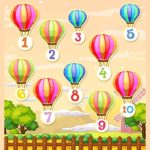Asthma is a disease that is chronic in nature and affects the airways of the lungs. It causes inflammation and narrowing of the airways which causes coughing, wheezing and tightness in the chest. When these symptoms get more pronounced than usual, it is called an asthma attack. In childhood asthma, the airways and lungs get easily inflamed due to certain triggers. These triggers could be anything from inhaling pollen to catching a cold or some other respiratory infection. Childhood asthma usually starts before 5 years of age and can interfere with a child’s sports, play, sleep and school. If left unmanaged, it can cause dangerous asthma attacks.
Children face unique challenges due to asthma with hospitalisations, emergency department visits and missed school days. Unfortunately, there is no cure for childhood asthma but with the right treatment symptoms can be kept under control and damage to growing lungs can be prevented.
Causes of Asthma in Children
An asthma attack happens due to certain triggers and different triggers cause different types of asthma. These triggers are different for each child and can change over time. The lungs and airways begin to swell and produce mucus because of increased immune system sensitivity when exposed to certain triggers. Sometimes the reaction may be delayed which makes it difficult to identify the trigger.
- Genetics and environment most likely play a role in causing asthma in children though the exact cause is not known. At times there’s a tendency to develop allergies that run in the family and sometimes it could be because the parents have asthma, especially if the mother has it.
- Allergic asthma is caused by allergens that cause an allergic reaction and include mould, pollen, pet dander, dust mites and droppings from cockroaches and mice.
- Nonallergic asthma is caused by triggers that are not allergens like certain medicines, breathing in cold air, chemicals in household cleaners, air pollution, tobacco smoke and infections such as colds and the influenza.
- Exercise-induced asthma attacks are caused while doing physical exercise, especially when the air is dry.
- Exposure to secondhand smoke as a foetus or when they are small children can cause asthma.
- Certain races or ethnicities are more prone to asthma like Blacks, Puerto Ricans and African Americans.
- Suffering from obesity and allergies can aggravate asthma.
- Exposure to viral respiratory infections as young children can cause asthma.
- Gender is also a factor as asthma is more common in boys during childhood and girls during the teenage years.
Asthma Symptoms in Children
Asthma symptoms in children include:
- Coughing, especially at night or early morning
- Chest tightness or congestion
- Breathing problems — rapid breathing, shortness of breath or gasping for air
- Tiredness
- Irritability
- Dark circles under the eyes
- Wheezing or whistling sound when they breathe out
- Trouble eating or sucking in the case of infants
- Inability to sleep because of persistent coughing, shortness of breath or wheezing
In some people these symptoms may occur often or once in a while and can be anything from mild to severe. Sometimes they can even be dangerous and life-threatening. A severe attack would have symptoms like persistent coughing, severe breathing problems and turning blue or very pale in the face, lips and fingernails. Immediate medical help is required immediately in such cases.
Treatment of Childhood Asthma
If your child has asthma, you will need to make a treatment plan along with their health care provider to manage their symptoms and prevent asthma attacks.
- You will need to implement strategies to avoid triggers. If cigarette smoke is an asthma trigger for your child, you should not allow anyone to smoke in your car or home.
- Short-term relief medicines which prevent or relieve symptoms during an asthma attack. They include carrying an inhaler for your child at all times. It may also include other types of medicines prescribed by a doctor which work quickly to open your child’s airways so that they can breathe easier.
- Depending on whether or not your child needs them, which is determined by how severe the asthma is and how frequently your child has symptoms, control medicines may be prescribed. These control medicines reduce inflammation in the airways and prevent their narrowing.
If your child has a severe asthma attack and the short-term relief medicines are not proving to be effective, you will need to get medical help right away.
Prevention of Childhood Asthma
Strategic planning and steering clear of asthma triggers are the best ways to prevent asthma attacks.
- Limit the exposure to asthma triggers as much as possible by helping your child to avoid the allergens and irritants that cause symptoms.
- Don’t allow anyone to smoke around your child as exposure to tobacco smoke during the early years is a major cause of childhood asthma as well as a trigger.
- Encourage your child to be as active as possible as regular physical activity helps the lungs to work more efficiently.
- See your child’s doctor when necessary and don’t ignore any sign that your child’s asthma might not be under control, like if they are recently using their inhaler too often.Also, asthma changes over time and checking in with your child’s doctor regularly can help in making treatment adjustments so that the symptoms are controlled.
- Help your child to maintain a healthy weight as being obese or overweight can worsen the symptoms of asthma and can also cause other health problems.
- Acid reflux or severe heartburn should be controlled as it might worsen your child’s asthma symptoms. Your child may need medication for this.
When to See a Doctor
Take your child to see a doctor as soon as you suspect that your child has asthma as timely treatment will help control the symptoms and prevent asthma attacks.
If you notice any of these symptoms, it’s time to book an appointment with your doctor:
- Constant coughing, intermittent coughing or coughing that occurs with any physical activity
- Wheezing or whistling sounds while breathing
- Rapid breathing or shortness of breath
- Chest tightness.
- Repeated episodes of bronchitis or pneumonia.
- Has to stop to take a breath in mid sentence
- Is using abdominal muscles to breathe
- Nostrils widen noticeably when breathing in.
- Is labouring so hard to breathe that the abdomen gets sucked in under the ribs while breathing.
Asthma is a disease that ails many children and usually strikes before the age of 5 years. It can be very traumatic for both the child and their family if it results in an asthma attack. Symptoms vary in severity and kind but a child usually has difficulty in breathing and may start wheezing. Timely intervention can alleviate the symptoms to a large extent and your child can lead a normal life. For more information and updates on the causes, symptoms, treatment and prevention of asthma in children, log into the EuroKids website for answers to your questions.
The information provided on this website is not a substitute for professional medical advice. EuroKids encourages you to consult with a qualified healthcare professional for any health concerns you may have. The information on this website is not intended to diagnose, treat, cure, or prevent any disease.















